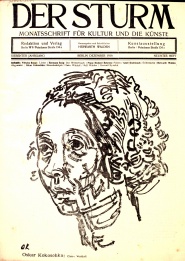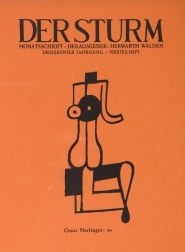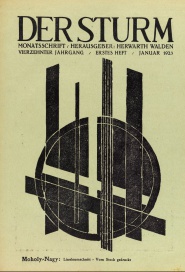Difference between revisions of "Der Sturm"
| Line 1: | Line 1: | ||
'''Der Sturm''' [The Storm] was a magazine covering the expressionism movement founded in Berlin in 1910 by [[Herwarth Walden]]. It ran weekly until monthly in 1914, and became a quarterly in 1924 until it ceased publication in 1932. | '''Der Sturm''' [The Storm] was a magazine covering the expressionism movement founded in Berlin in 1910 by [[Herwarth Walden]]. It ran weekly until monthly in 1914, and became a quarterly in 1924 until it ceased publication in 1932. | ||
| + | |||
| + | {{TOC limit|3}} | ||
| + | |||
Among the literary contributors were Peter Altenberg, Max Brod, Richard Dehmel, Alfred Döblin, Anatole France, Knut Hamsun, Arno Holz, Karl Kraus, Selma Lagerlöf, Adolf Loos, Heinrich Mann, Paul Scheerbart, and René Schickele. ''Der Sturm'' consisted of pieces such as expressionistic dramas (i.e. from Hermann Essig and August Stramm), artistic portfolios ([[Oskar Kokoschka]]), essays from artists (the Kandinsky Album), and theoretical writings on art from Herwarth Walden. The most well-known publications resulting from the magazine were the ''Sturmbücher'' (storm-books), (e.g. ''Sturmbücher'' 1 and 2 were works of August Stramm – ''Sancta Susanna'' and ''Rudimentär''). Postcards were also created featuring the expressionistic, cubist, and abstract art of [[Franz Marc]], [[Wassily Kandinsky]], [[Oskar Kokoschka]], [[August Macke]], [[Gabriele Münter]], [[Georg Schrimpf]], [[Maria Uhden]], [[Rudolf Bauer]] and others. The term ''Sturm'' was branded by Walden to represent the way in which modern art was penetrating Germany at the time. | Among the literary contributors were Peter Altenberg, Max Brod, Richard Dehmel, Alfred Döblin, Anatole France, Knut Hamsun, Arno Holz, Karl Kraus, Selma Lagerlöf, Adolf Loos, Heinrich Mann, Paul Scheerbart, and René Schickele. ''Der Sturm'' consisted of pieces such as expressionistic dramas (i.e. from Hermann Essig and August Stramm), artistic portfolios ([[Oskar Kokoschka]]), essays from artists (the Kandinsky Album), and theoretical writings on art from Herwarth Walden. The most well-known publications resulting from the magazine were the ''Sturmbücher'' (storm-books), (e.g. ''Sturmbücher'' 1 and 2 were works of August Stramm – ''Sancta Susanna'' and ''Rudimentär''). Postcards were also created featuring the expressionistic, cubist, and abstract art of [[Franz Marc]], [[Wassily Kandinsky]], [[Oskar Kokoschka]], [[August Macke]], [[Gabriele Münter]], [[Georg Schrimpf]], [[Maria Uhden]], [[Rudolf Bauer]] and others. The term ''Sturm'' was branded by Walden to represent the way in which modern art was penetrating Germany at the time. | ||
| Line 6: | Line 9: | ||
===Issues=== | ===Issues=== | ||
| + | {| class="imgtable" | ||
| + | | | ||
| + | [[Image:Der_Sturm_1916-09.jpg|thumb|185px|''Der Sturm'' 9 (1916). [http://bluemountain.princeton.edu/bluemtn/cgi-bin/bluemtn?a=d&d=bmtnabg19161215-01 View online].]] | ||
| + | | | ||
| + | [[Image:Der_Sturm_1922-04.jpg|thumb|185px|''Der Sturm'' 4 (1922). [http://bluemountain.princeton.edu/bluemtn/cgi-bin/bluemtn?a=d&d=bmtnabg19220405-01 View online].]] | ||
| + | | | ||
| + | [[Image:Der_Sturm_1923-01.jpg|thumb|185px|''Der Sturm'' 1 (1923). [http://bluemountain.princeton.edu/bluemtn/cgi-bin/bluemtn?a=d&d=bmtnabg192301-01 View online].]] | ||
| + | |} | ||
| + | |||
[http://bluemountain.princeton.edu/bluemtn/cgi-bin/bluemtn?a=cl&cl=CL1&sp=bmtnabg&ai=1 The Blue Mountain project] hosts scans of the full run of the magazine (336 issues). | [http://bluemountain.princeton.edu/bluemtn/cgi-bin/bluemtn?a=cl&cl=CL1&sp=bmtnabg&ai=1 The Blue Mountain project] hosts scans of the full run of the magazine (336 issues). | ||
| Line 14: | Line 26: | ||
==Literature== | ==Literature== | ||
| − | * | + | * Peter Howard Selz, in [http://books.google.com/books?id=wGqz5SKkQSkC&pg=PA250 "Der Sturm"], ''German Expressionist Painting'', University of California Press, 1974. |
| − | Peter Howard Selz, in [http://books.google.com/books?id=wGqz5SKkQSkC&pg=PA250 "Der Sturm"], ''German Expressionist Painting'', University of California Press, 1974. | ||
==External links== | ==External links== | ||
Revision as of 17:31, 3 January 2014
Der Sturm [The Storm] was a magazine covering the expressionism movement founded in Berlin in 1910 by Herwarth Walden. It ran weekly until monthly in 1914, and became a quarterly in 1924 until it ceased publication in 1932.
Among the literary contributors were Peter Altenberg, Max Brod, Richard Dehmel, Alfred Döblin, Anatole France, Knut Hamsun, Arno Holz, Karl Kraus, Selma Lagerlöf, Adolf Loos, Heinrich Mann, Paul Scheerbart, and René Schickele. Der Sturm consisted of pieces such as expressionistic dramas (i.e. from Hermann Essig and August Stramm), artistic portfolios (Oskar Kokoschka), essays from artists (the Kandinsky Album), and theoretical writings on art from Herwarth Walden. The most well-known publications resulting from the magazine were the Sturmbücher (storm-books), (e.g. Sturmbücher 1 and 2 were works of August Stramm – Sancta Susanna and Rudimentär). Postcards were also created featuring the expressionistic, cubist, and abstract art of Franz Marc, Wassily Kandinsky, Oskar Kokoschka, August Macke, Gabriele Münter, Georg Schrimpf, Maria Uhden, Rudolf Bauer and others. The term Sturm was branded by Walden to represent the way in which modern art was penetrating Germany at the time.
Particularly in the time before outbreak of the World War I, Der Sturm played a crucial role in the French-German exchange of expressionist artists, which led to a special relationship between Berlin and Paris. Regularly, poems and other texts of French and/or French-speaking expressionists were published (Guillaume Apollinaire, Blaise Cendrars, etc.). This relationship was renewed after the war despite the hostilities between the two countries caused by the fighting.
Issues
 Der Sturm 9 (1916). View online. |
 Der Sturm 4 (1922). View online. |
 Der Sturm 1 (1923). View online. |
The Blue Mountain project hosts scans of the full run of the magazine (336 issues).
The Gallery
The magazine also fostered the Galerie Der Sturm, started by Walden to celebrate its 100th edition, in 1912. The gallery became the focus for Berlin's modern art scene for a decade. Starting with an exhibition of Fauves and Der Blaue Reiter, followed by the introduction in Germany of the Italian Futurists, Cubists and Orphists, the gallery was to exhibit Edvard Munch, Georges Braque, Pablo Picasso, Albert Gleizes, Robert Delaunay, Jean Metzinger, Gino Severini, Jean Arp, Paul Klee, Wassily Kandinsky, and Kurt Schwitters.
After the war, Walden expanded Der Sturm into "Sturmabende", lectures and discussions on modern art, and "Die Sturmbühne", an expressionist theatre, as well as publishing books and portfolios by leading artists such as Oskar Kokoschka. Despite this, the gallery declined in importance after the war and closed in 1924, leaving the magazine to carry on as a quarterly until it too closed in 1932.
Literature
- Peter Howard Selz, in "Der Sturm", German Expressionist Painting, University of California Press, 1974.
External links
| Avant-garde and modernist magazines | ||
|---|---|---|
|
Poesia (1905-09, 1920), Der Sturm (1910-32), Blast (1914-15), The Egoist (1914-19), The Little Review (1914-29), 291 (1915-16), MA (1916-25), De Stijl (1917-20, 1921-32), Dada (1917-21), Noi (1917-25), 391 (1917-24), Zenit (1921-26), Broom (1921-24), Veshch/Gegenstand/Objet (1922), Die Form (1922, 1925-35), Contimporanul (1922-32), Secession (1922-24), Klaxon (1922-23), Merz (1923-32), LEF (1923-25), G (1923-26), Irradiador (1923), Sovremennaya architektura (1926-30), Novyi LEF (1927-29), ReD (1927-31), Close Up (1927-33), transition (1927-38). | ||
| Full list | ||
|---|---|---|
|
Entretiens politiques et littéraires (1890-93), Moderní revue (1894-1925), Volné směry (1897-1948), Mir iskusstva (1898-1904), Vesy (1904-09), Poesia (1905-09, 1920), Zolotoe runo (1906-10), The Mask (1908-29), Apollon (1909-17), Ukraïnska khata (1909-14), Der Sturm (1910-32), Thalia (1910-13), Rhythm (1911-13), Trudy i dni (1912), Simbolul (1912), The Glebe (1913-14), Ocharovannyi strannik (1913-16), Revolution (1913), Blast (1914-15), The Little Review (1914-29), Futuristy (1914), Zeit-Echo (1914-17), The Egoist (1914-19), L'Élan (1915-16), 291 (1915-16), Orpheu (1915), La Balza futurista (1915), MA (1916-25), SIC (1916-19), flamman (1916-21), The Blindman (1917), Nord-Sud (1917-18), De Stijl (1917-20, 1921-32), Dada (1917-21), Klingen (1917-20, 1942), Noi (1917-25), 391 (1917-24), Modernisme et compréhension (1917), Anarkhiia (1917-18), Iskusstvo kommuny (1918-19), Formiści (1919-21), S4N (1919-25), La Cité (1919-35), Aujourd'hui (1919), Exlex (1919-20), L'Esprit nouveau (1920-25), Orfeus (1920-21), Action (1920-22), Proverbe (1920-22), Ça ira (1920-23), Zenit (1921-26), Kinofon (1921-22), Het Overzicht (1921-25), Jednodńuwka futurystuw (1921), Nowa sztuka (1921-22), Broom (1921-24), Život (1921-48), Creación (1921-24), Jar-Ptitza (1921-26), New York Dada (1921), Aventure (1921-22), Spolokhi (1921-23), Gargoyle (1921-22), Veshch/Gegenstand/Objet (1922), Kino-fot (1922-23), Le Coeur à barbe (1922), Die Form (1922, 1925-35), 7 Arts (1922-28), Manomètre (1922-28), Ultra (1922), Út (1922-25), Dada-Jok (1922), Dada Tank (1922), Dada Jazz (1922), Mécano (1922-23), Contimporanul (1922-32), Zwrotnica (1922-23, 1926-27), Secession (1922-24), Stavba (1922-38), Gostinitsa dlya puteshestvuyuschih v prekrasnom (1922-24), Putevi (1922-24), Klaxon (1922-23), Akasztott Ember (1922-23), MSS (1922-23), Perevoz Dada (1922-49), Egység (1922-24), L'Architecture vivante (1923-33), Merz (1923-32), LEF (1923-25), G (1923-26), The Next Call (1923-26), Russkoye iskusstvo (1923), Disk (1923-25), Irradiador (1923), Surréalisme (1924), Almanach Nowej Sztuki (1924-25), La Révolution surréaliste (1924-29), Blok (1924-26), Pásmo (1924-26), DAV (1924-37), Bulletin de l'Effort moderne (1924-27), ABC (1924-28), CAP (1924-28), Athena (1924-25), Punct (1924-25), 75HP (1924), Le Tour de Babel (1925), Periszkop (1925-26), Integral (1925-28), Praesens (1926, 1930), Sovremennaya architektura (1926-30), bauhaus (1926-31), Das neue Frankfurt (1926-31), L'Art cinématographique (1926-31), Dokumentum (1926-27), Kritisk Revy (1926-28), Novyi LEF (1927-29), i 10 (1927-29), Nova generatsiia (1927-30), ReD (1927-31), Dźwignia (1927-28), Tank (1927-28), Close Up (1927-33), Horizont (1927-32), transition (1927-38), Discontinuité (1928), Munka (1928-39), Quosego (1928-29), Urmuz (1928), Unu (1928-32), Revista de Antropofagia (1928-29), 50 u Evropi (1928-29), Documents (1929-30), L'Art Contemporain - Sztuka Współczesna (1929-30), Adam (1929-40), Art concret (1930), Zvěrokruh (1930), Alge (1930-31), Le Surréalisme au service de la révolution (1930-33), Levá fronta (1930-33), Kvart (1930-37, 1945-49), Nová Bratislava (1931-32), Linja (1931-33), Spektrum (1931-33), Nadrealizam danas i ovde (1931-32), Ulise (1932-33), Die neue Stadt (1932-33), Mouvement (1933), PLAN (1933-36), Karavan (1934-35), Ekran (1934), Axis (1935-37), Acéphale (1936-39), Telehor (1936), aka (1937-38), Plastique (1937-39), Plus (1938-39), Les Réverbères (1938-39). | ||